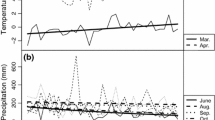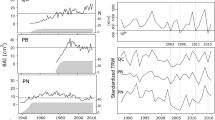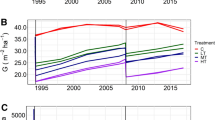Abstract
Recent land-use changes in intensively managed forests such as Mediterranean coppice stands might profoundly alter their structure and function. We assessed how the abandonment of traditional management practices in coppice stands, which consisted of short cutting-cycles (10–15 years), has caused overaging (stems are usually much older than when they were coppiced) and altered their wood anatomy and hydraulic architecture. We studied the recent changes of wood anatomy, radial growth, and hydraulic architecture in two stands of Quercus pyrenaica, a transitional Mediterranean oak with ring-porous wood forming coppice stands in W–NW Spain. We selected a xeric and a mesic site because of their contrasting climates and disturbance histories. The xeric site experienced an intense defoliation after the severe 1993–1994 summer drought. The mesic site was thinned in late 1994. We studied the temporal variability in width, vessel number and diameter, and predicted the hydraulic conductivities (K h) of earlywood and latewood. In the mesic site, we estimated the vulnerability to xylem cavitation of earlywood vessels. Overaging caused a steep decline in latewood production at a cambial age of 14 years., which was close to the customary cutting cycle of Q. pyrenaica. The diameter distribution of vessels was bimodal, and latewood vessels only accounted for 4% of the K h. Overaging, acting as a predisposing factor in the decline episode, was observed at the xeric site, where most trees did not produce latewood in 1993–1995. At the mesic site, thinned trees formed wider tree-rings, more latewood and multiseriate tree-rings than overaged trees. The growth enhancement remained 8 years after thinning. Most of the hydraulic conductivity in earlywood was lost in a narrow range of potentials, between −2.5 and −3.5 MPa. We have shown how hydraulic conductivity and radial growth are closely related in Q. pyrenaica and how aging modulates this relationship.





Similar content being viewed by others
References
Allué M, San Miguel A (1991) Estructura, evolución y producción de tallares de Quercus pyrenaica Willd. en el centro de España. Inv Agric Sist Rec For 0:35–48
Amorini E, Bruschini S, Cutini A, Fabbio G, Manetti MC (1996) Silvicultural treatment of holm oak (Quercus ilex L.) coppices in Southern Sardinia: thinning and related effects on stand structure and canopy cover. Ann Inst Sperim Selvic 27:167–176
Barberó M, Bonin G, Loisel R, Quézel P (1990) Changes and disturbances of forest ecosystems caused by human activities in the western part of the Mediterranean basin. Vegetatio 87:151–173
Blanco E, Casado MA, Costa M, Escribano R, García M, Génova M, Gómez A, Gómez F, Moreno JC, Morla C, Regato P, Sáinz H (1997) Los Bosques Ibéricos: Una interpretación geobotánica. Planeta, Madrid
Blondel J, Aronson J (1999) Biology and wildlife of the Mediterranean region. Oxford University Press, New York
Bréda N, Granier A, Aussenac G (1995) Effects of thinning on soil and tree water relations, transpiration and growth in an oak forest (Quercus petraea (Matt.) Liebl.). Tree Physiol 15:295–306
Cañellas I, Montero G, San Miguel A, Montoto JL, Bachiller A (1994) Transformation of rebollo oak coppice (Quercus pyrenaica Willd.) into open woodlands by thinning at different intensities. Inv Agric Sist Rec For 3:71–78
Cañellas I, Montero G, Bachiller A (1996) Transformation of quejigo oak (Quercus pyrenaica Lam.) coppice forest into high forest by thinning. Ann Inst Sperim Selvic 27:143–147
Cañellas I, del Río M, Roig S, Montero G (2004) Growth response to thinning in Quercus pyrenaica Willd. coppice stands in Spanish central mountain. Ann For Sci 61:243–250
Carlquist S (1975) Ecological strategies of xylem evolution. University of California Press, Los Angeles
Ceballos L, Ruiz de la Torre J (1979) Árboles y arbustos de la España peninsular. ETSIM, Madrid
Cochard H, Cruiziat P, Tyree MT (1992) Use of pressures to establish vulnerability curves. Plant Physiol 100:205–209
Cook ER, Kairiukstis LA (1990) Methods of dendrochonology: applications in the environmental sciences. Kluwer, Dordrecht
Corcuera L (2003) Respuesta al clima de distintas especies del género Quercus: Estructura y funcionamiento comparado. PhD thesis, Universitat de Lleida, Spain
Corcuera L, Camarero JJ, Gil-Pelegrín E (2002) Functional groups in Quercus species derived from the analysis of pressure-volume curves. Trees 16:465–472
Corcuera L, Camarero JJ, Gil-Pelegrín E (2004a) Effects of a severe drought on Quercus ilex radial growth and xylem anatomy. Trees 18:83–92
Corcuera L, Camarero JJ, Gil-Pelegrín E (2004b) Effects of a severe drought on growth and wood-anatomical properties of Quercus faginea. IAWA J 25:185–204
Ellmore GS, Ewers FW (1986) Fluid flow in the outermost xylem increment of a ring-porous tree, Ulmus americana. Am J Bot 73:1771–1774
Floret C, Galán MJ, Le Floɣh E, Rapp M, Romane F (1989) Organisation de la structure, de la minéralomasse dún taillis ouvert de chȴne vert (Quercus ilex L.). Acta Oecol/Oecol Plant 10:245–262
Fritts HC (1976) Tree rings and climate. Academic Press, New York
Führer E (1998) Oak decline in Central Europe: a synopsis of hypotheses. In: McManus ML, Liebhold AM (eds) Proceedings: population dynamics, impacts, and integrated management of forest defoliating insects. USDA For Serv Gen Technol Rep NE-247, pp 7–24
Giovannini G, Perulli D, Piussi P, Salbitano F (1992) Ecology of vegetative regeneration after coppicing in macchia stand in central Italy. Vegetatio 99-100:331–343
Holmes RL (1983) Computer-assisted quality control in tree-ring dating and measurement. Tree-Ring Bull 43:69–78
IPCC (2001) Climate change 2001: the scientific basis. Cambridge University Press, Cambridge, UK
Jarbeau JA, Ewers FW, Davis SD (1995) The mechanism of water-stress-induced embolism in two species of chaparral shrubs. Plant Cell Environ 18:189–196
Jiménez Sancho MP, Díaz Fernández PM, Martín Albertos S, Gil Sánchez L (1998) Regiones de procedencia: Quercus pyrenaica Willd., Quercus faginea Lam. y Quercus canariensis Willd. OAPN, Madrid
Lo Gullo MA, Salleo S (1991) Three different methods for measuring xylem cavitation and embolism: a comparison. Ann Bot 67:417–424
Lo Gullo MA, Salleo S, Piaceri EC, Rosso R (1991) Relations between vulnerability to xylem embolism and xylem conduit dimensions in young trees of Quercus cerris. Plant Cell Environ 18:661–669
Manion PD (1991) Tree disease concepts. Prentice-Hall, Englewood Cliffs, NJ
Manion PD, Lachance D (1992) Forest decline concepts. APS Press, St. Paul, MN
Mencuccini M, Grace J (1995) Climate influences the leaf area/sapwood area ratio in Scots pine. Tree Physiol 15:1–10
Peñuelas J, Lloret F, Montoya R (2001) Severe drought effects on Mediterranean woody flora. For Sci 47:214–218
Serrada R, Allué M, San Miguel A (1992) The coppice system in Spain. Current situation, state of art and major areas to be investigated. Ann Inst Sperim Selvic 23:266–275
Sperry JS (1986) Relationship of xylem embolism to xylem pressure potential, stomatal closure, and shoot morphology in the palm Rhapis excelsa. Plant Physiol 80:110–116
Sperry JS, Nichols KL, Sullivan JEM, Eastlack SE (1994) Xylem embolism in ring-porous, diffuse-porous, and coniferous trees of northern Utah and interior Alaska. Ecology 75:1736–1752
Sperry JS, Pockman WT (1993) Limitation of transpiration by hydraulic conductance and xylem cavitation in Betula occidentalis. Plant Cell Environ 16:279–287
Stokes MA, Smiley TL (1968) An introduction to tree-ring dating. University of Chicago Press, Chicago
Thomas FM, Hartmann G (1996) Soil and tree water relations in mature oak stands of northern Germany differing in the degree of decline. Ann Sci For 53:697–720
Tyree MT, Sinclair B, Lu P, Granier A (1993) Whole shoot hydraulic resístanse in Quercus species measured with a new high-pressure flowmeter. Ann Sci For 50:417–423
Tyree MT, Cochard H (1996) Summer and winter embolism in oak: impact on water relations. Ann Sci For 53:173–180
Tyree MT, Davis SD, Cochard H (1994) Biophysical perspectives of xylem evolution: is there a tradeoff of hydraulic efficiency for vulnerability to dysfunction? IAWA J 15:335–360
Villar-Salvador P, Castro Díez P, Pérez Rontomé C, Montserrat Martí G (1997) Stem xylem features in three Quercus (Fagaceae) species along a climatic gradient in NE Spain. Trees 12:90–96
Vitousek PM (1994) Beyond global warming: ecology and global change. Ecology 75:1861–1876
Woodcock D (1989) Climate sensitivity of wood-anatomical features in a ring-porous oak (Quercus macrocarpa). Can J For Res 19:639–644
Yamaguchi DK (1991) A simple method for cross-dating increment cores from living trees. Can J For Res 21:414–416
Zimmermann MH (1983) Xylem structure and the ascent of sap. Springer, Berlin
Acknowledgements
This study was supported by 1FD97-0911-C03-01 project and INIA grant to LC. We thank the staff of Moncayo Natural Park (Gob. Aragón) for their help in the field, and G. Montserrat-Martí (IPE, CSIC) for the use of the microtome. LC and JJC acknowledge the financial support of INIA-Gob. Aragón postdoctoral contracts.
Author information
Authors and Affiliations
Corresponding author
Rights and permissions
About this article
Cite this article
Corcuera, L., Camarero, J.J., Sisó, S. et al. Radial-growth and wood-anatomical changes in overaged Quercus pyrenaica coppice stands: functional responses in a new Mediterranean landscape. Trees 20, 91–98 (2006). https://doi.org/10.1007/s00468-005-0016-4
Received:
Accepted:
Published:
Issue Date:
DOI: https://doi.org/10.1007/s00468-005-0016-4




